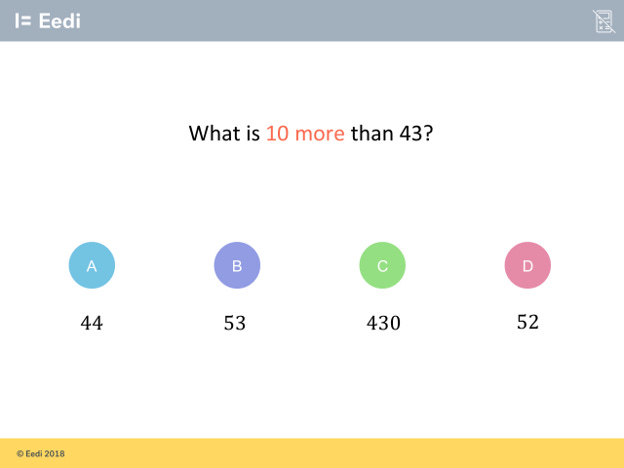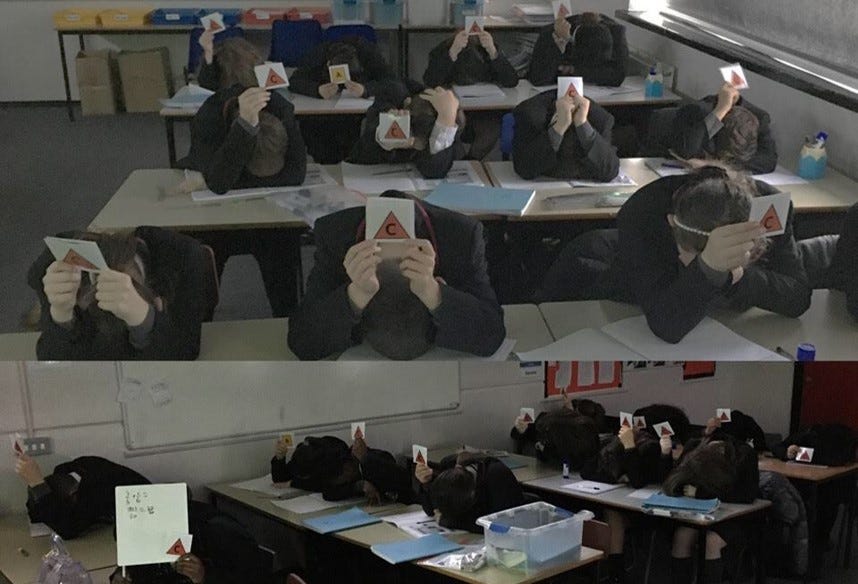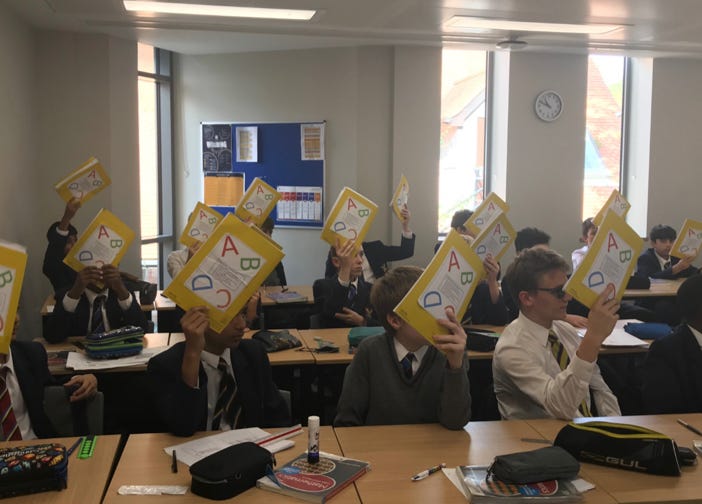Hello, and welcome to the Tips for Teachers newsletter. For over 400 ideas to try out the very next time you step into the classroom, check out my Tips for Teacher book.
💡 A quick tip to try in class this week 💡
I love multiple-choice diagnostic questions.
Diagnostic questions are fantastic at identifying a specific misunderstanding students have, allowing the teacher to provide bespoke intervention that they have planned in advance (If students select C, it is likely because they think 10 more than means 10 times, so I will do this…)
Students can respond to diagnostic questions in lots of ways: using fingers, on mini-whiteboards, or with some fancy app. But for my money, nothing beats a coloured set of ABCD cards. Look how easy it is for the teacher to get a sense of the spread of students’ answers in the image on the right compared to when students respond on mini-whiteboards in the image on the left:
But one problem coloured ABCD cards have is that students can easily see the responses of their classmates by looking at the back of them:
This means it can be easy for a student to quickly change their choice of card based on the responses of their classmates, especially if they are sitting behind other students. Now, all of a sudden your check for understanding has lost validity as you no longer know what each individual student really thinks.
There are two ways I see teachers get around this:
Heads down, cards up.
We have already seen this in action in the photo above
With students’ heads lowered, they are unable to see the responses of their classmates
Make the backs of the cards blank
This can be as simple as covering the backs of the coloured ABCD cards with white paper. Or you can do what this school did and stick the voting cards to students’ books and let the orientation indicate their choice of answer:
Of course, in the long-term, we want a culture in our classrooms where the questions we ask students have low stakes and students do not fear being wrong, so students are prepared to be honest about their choice of answer. But if we are looking for some short-term, practical solutions to increase the reliability of our checks for understanding, one of these two ideas might be useful.
You can find tens of thousands of free diagnostic questions on my website diagnosticquestions.com.
What would you need to change to make this tip work for you?
When could you try it for the first time?
View all the Tips for Teachers shared so far
📺 A video to discuss with a colleague 📺
Maths teacher and author, Michael Pershan, describes how “What if?” is one of his favourite questions to ask during modelling
If the video doesn't play when you click on it, click here
Subscribe to the Tips for Teachers YouTube channel so you never miss a tip
👂 A podcast episode to listen to on your way home 👂
Teacher and podcaster, Femi Adeniran, shares his five tips:
Teach behaviour lesson one by making ‘developing the right classroom culture’ your objective for the early lessons
Focus on explanations, not resources
Teach in small chunks and fool kids into doing lots of work initially
Have your coffee whilst sitting in the classrooms of effective teachers
Provide answers so pupils can check their work in real-time
Listen to the podcast here.
Search for Tips for Teachers on any podcast platform (Apple Podcasts, Spotify, etc) and subscribe so you never miss an episode.
😎 Final bits and bobs 😎
Do you know someone who would enjoy this newsletter? Forward it to them, or direct them to the sign-up page here where you can also read all previous editions.
You can also sign up to my weekly Eedi newsletter, where I share resources, research and ideas to improve teaching and learning.
Check out my Tips for Teachers book
Do you and your team want high-quality training or coaching, with ideas you can use in your very next lesson? If so, you can book some Tips for Teachers CPD
Check out the all-new Tips for Teachers online courses
If you value my work, please consider becoming a Patreon








